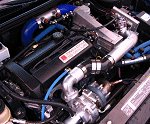

|
Street Class Unlimited Class
DOHC SOHC Ion Updated 1/05 For the most recent list of the fastest five cars click here. |
Techedge Version 2.0 Wideband Construction
|
|
#R |
Value |
Location |
|
3 |
0R22 5% |
R107, R108, R109 |
|
1 |
150R 5% |
R4 |
|
6 |
1k0 5% |
R110, R113, R203, R216, R225, R412 |
|
2 |
1k5 5% |
R1, R3 |
|
4 |
2k2 5% |
R301, R302, R405, R407 |
|
1 |
4k7 5% |
R403 |
|
7 |
10k 5% |
R111, R112, R402, R404, R413, R414, R415 |
|
1 |
27k 5% |
R423 |
|
2 |
22k 5% |
R221, R226 |
|
3 |
47k 5% |
R105, R406, R422 |
|
5 |
100k 5% |
R416, R417, R418, R419, R420 |
|
1 |
470k 5% |
R421 |
|
1 |
1M 5% |
R408 |
|
1 |
10R 1W 5% |
R2 |
|
1 |
15k 1W 5% |
R401 |
Starting at the beginning, find the locations on the board R110,
R113, R203, R216, R225, R412 and bend the leads on the resistor
as close to the resistor as possible. The press the resistor into
each slot as the number corresponds. You may need to bend the leads
so that the resistors don't fall out when you turn the board upside
down. Continue this down the table. Once you have a group of 10
or so resistors in place, you can solder them in. Be sure to add
a little solder to your iron before you start. Turn the board over
and set it down on your workstation. Solder by touching the tip
of the iron to both the lead and the metal ring on the board. Then
touch the solder to the joint where the iron touches the lead and
the ring. The solder will jump into the hole when you pull back
the iron. This may take practice for beginners. NOTE: DO NOT INSTALL
R2 YET. This resistor must be installed standing straight up and
down. You must install the Ethernet connector first. R401 is the
bicycle symbol on the bottom left-hand corner.
Once you have soldered all of the resistors above, go on to the 1% resistors and repeat. The 1% resistors will be all that's left; they are usually blue/green and have a black or brown strip on one end.
It's easiest to start with the lowest lying components on the board, so you'll want to install in the following order, Resistors, capacitors, diodes, crystals, IC sockets, and then everything else. You may want to install the test pins before the IC sockets. Soldering the IC sockets will be far easier if you have rubber clamps to hold them on the board. Construction of the unit will be time consuming. Once you have completed it, go on to the display.
Once all is complete, tap the positive wire into your 12+ ignition wire. There is a ground on the driver's side of the radio console. Simply remove the nut and screw the ground wire in. Run the NB output to your pcm if you would like the pcm to get a more accurate O2 reading while running.
If you ordered the cheaper VW sensor you will have to make a bung and thread it into your exhaust manifold. NA cars will need to mount the sensor further down the exhaust stream than the factory location as the sensor will overheat. Turbo cars can just use their regular O2 housing.
Testing:
To make sure your unit is fully functional; follow the directions
on the website. The following has been taken directly from the site.
"Test Point and Connector Voltages
Test condition with 6066 sensor J1 - installed, J2 in the 2-3 position,
J3 in the 1-2 position. Negative (Black) lead of DVM on GND (left)
end of D2. Sensor in free-air. Battery voltage of 12.0 Volts. The
voltages (in red) are for when butane is briefly squirted into the
end of the sensor and these voltages rapidly change back as the
butane dissipates from around the sensor element. The "butane
voltages" are just a rough check that the unit is working.
Note that these voltages were obtained from a production unit and
the calibration set for a 6066 sensor. 7057 sensor values should
be similar. The readings may also depend on the type of meter you
use.
Test Points (grouped as on PCB)
Ip Tp1 2.74 (1.30)
Vpb Tp2 3.30 (0.67)
NBsim Tp6 0.02 (0.90)
SVout Tp5 4.05 (1.05)
WBLin Tp3 5.03 (0.01)
WBVout Tp4 3.53 (0.05)
Circular connector - Y3
Vs Y3-1 2.48 (2.48)
Vs/Ip Y3-2 2.01
Ip Y3-3 2.75 (1.45)
IpCal Y3-4 2.91 (1.05)
VGND Y3-5 2.01 (as for Y3-2)
H- Y3-6 5.0 (blow into sensor to cool heater-may go down to 1.0
Volt)
H+ Y3-7 12.0 (battery voltage)
RJ45 I/O Connector - Y1
SVout Y1-1 4.05 (as for SVout)
Rx Y1-2 0 (-9.0 Volts if PC connected)
Tx Y1-3 -9.0
WBlin Y1-4 5.03 (as for WBlin)
GND Y1-5 0 (GND)
NBSim Y1-6 0.02 (as for NBSim)
WBVout Y1-7 3.53 (as for WBVout)
VBatt Y1-8 12.0 (as for Battery, 0.9 less if LD01 connected)
Once you've verified that everything is working correctly, go try
it out!

The turbosaturns.net forum has become one of the best resources for Saturn performance on the net. Our members are constantly pushing their cars to new performance levels. So, log in, share your ideas, and help push your car’s performance to the next level.

- Apexi Safc Install
- Turbo Tuning
- Cams 101
- Wastegate 101
- HP vs Torque
- Ian's Turbo F.A.Q.
- Oxygen Sensors
- DIY Fuel Regulator
- Taming Detonation
- Walbro Install
- Fuel Injectors
- Techedge Wideband
- OEM Fuel Pump Limits
- AVC-R Programming
- Dynosoft
- 220whp or Bust
Archived Articles
HERE
![]()
August 2005 TSN will be holding its first ever meet in Chardon, Ohio. Some of the fastest Saturns in the country will be attending. Activities will include drag racing, dyno, tech session, and BBQ. Look for the latest information in the forums.
Different Racing

Jeff and his team Different Racing have big plans on breaking into some really low quarter mile times this year. Last year he posted a 12.40 on a pretty healthy nitrous shot. This year he has a new turbo setup and some serious determination. Visit his website for the latest news and information. I expect we'll be seeing some low 12's from him by the end of the year.
